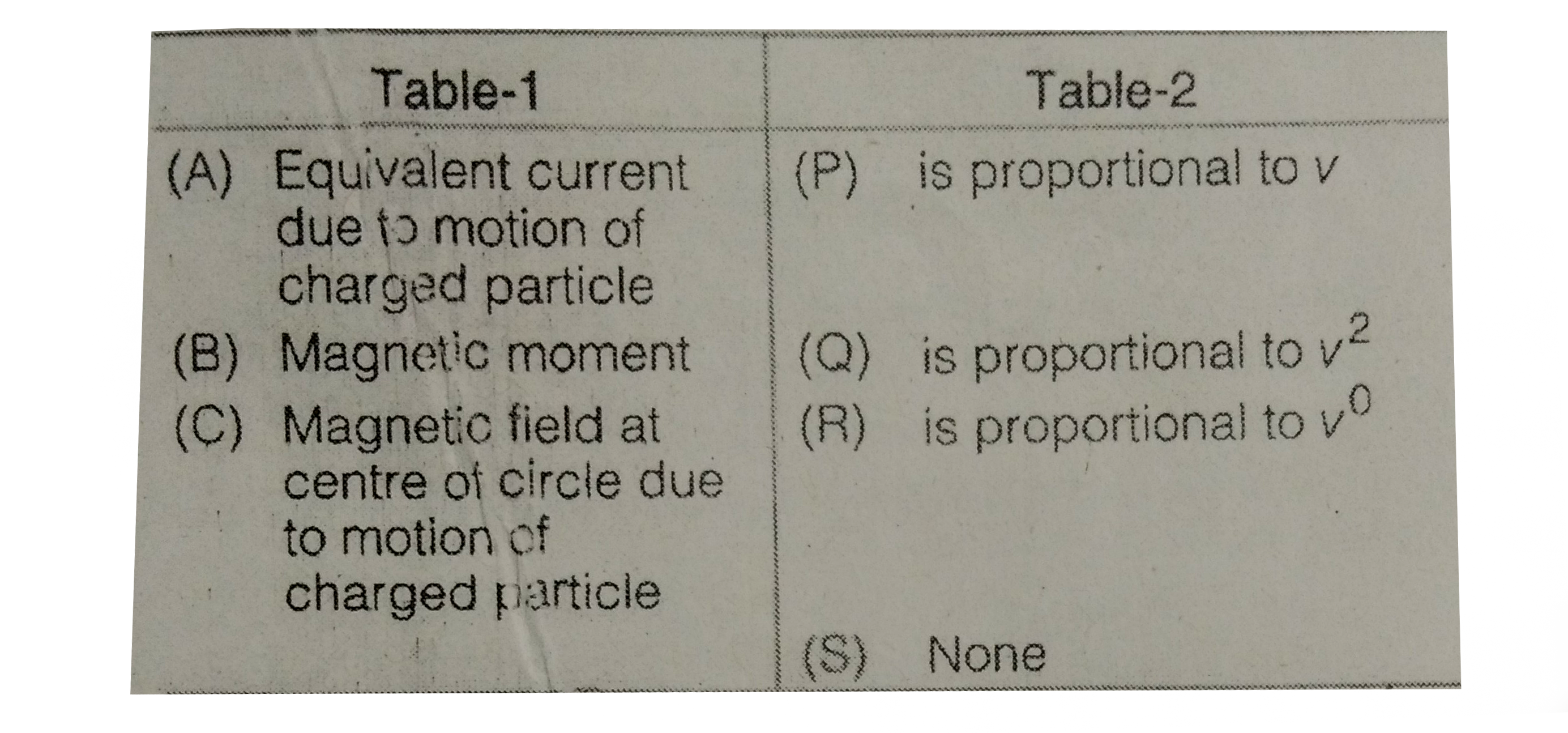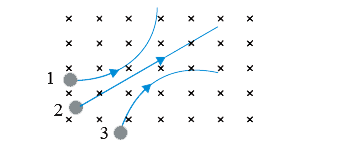A particle is projected in a plane perpendicular to a uniform magnetic field. The area bounded by the path described by the particle is proportional to
the velocity
the momentum
the kinetic energy
none of these
The correct Answer is:C
To solve the problem, we need to analyze the motion of a charged particle projected in a plane perpendicular to a uniform magnetic field. We'll derive the relationship between the area bounded by the path of the particle and its velocity, mass, and charge.
1. Understanding the Setup:
- We have a uniform magnetic field (B) directed into the plane of the paper.
- A charged particle (with charge Q) is projected with an initial velocity (V) perpendicular to this magnetic field.
2. Determine the Force on the Particle:
- The magnetic force (F) acting on the charged particle can be expressed using the formula:
F=Q(V×B)
- Since V is perpendicular to B, the magnitude of the magnetic force is:
F=QVB
3. Centripetal Force:
- The particle will move in a circular path due to the magnetic force acting as the centripetal force. The centripetal force required for circular motion is given by:
Fc=mv2R
- Where m is the mass of the particle and R is the radius of the circular path.
4. Equating Forces:
- Setting the magnetic force equal to the centripetal force, we have:
QVB=mv2R
5. Solving for the Radius (R):
- Rearranging the equation to solve for R gives:
R=mvQB
6. Calculating the Area (A):
- The area (A) of the circular path traced by the particle is given by:
A=πR2
- Substituting the expression for R:
A=π(mvQB)2
- Expanding this gives:
A=πm2v2Q2B2
7. Proportionality:
- From the expression for area, we can see that:
A∝m2v2
- This indicates that the area is proportional to the square of the velocity of the particle.
8. Conclusion:
- The area bounded by the path described by the particle is proportional to the square of its velocity, which is also related to the kinetic energy of the particle (since kinetic energy KE∝12mv2).
- Therefore, the area is proportional to the kinetic energy of the particle.
Final Answer:
The area bounded by the path described by the particle is proportional to the kinetic energy of the particle.
---
- We have a uniform magnetic field (B) directed into the plane of the paper.
- A charged particle (with charge Q) is projected with an initial velocity (V) perpendicular to this magnetic field.
- The magnetic force (F) acting on the charged particle can be expressed using the formula:
F=Q(V×B)
- Since V is perpendicular to B, the magnitude of the magnetic force is:
F=QVB
- The particle will move in a circular path due to the magnetic force acting as the centripetal force. The centripetal force required for circular motion is given by:
Fc=mv2R
- Where m is the mass of the particle and R is the radius of the circular path.
- Setting the magnetic force equal to the centripetal force, we have:
QVB=mv2R
- Rearranging the equation to solve for R gives:
R=mvQB
- The area (A) of the circular path traced by the particle is given by:
A=πR2
- Substituting the expression for R:
A=π(mvQB)2
- Expanding this gives:
A=πm2v2Q2B2
- From the expression for area, we can see that:
A∝m2v2
- This indicates that the area is proportional to the square of the velocity of the particle.
- The area bounded by the path described by the particle is proportional to the square of its velocity, which is also related to the kinetic energy of the particle (since kinetic energy KE∝12mv2).
- Therefore, the area is proportional to the kinetic energy of the particle.
The area bounded by the path described by the particle is proportional to the kinetic energy of the particle.
Topper's Solved these Questions
- BOOK - VMC MODULES ENGLISHCHAPTER - MOVING CHARGES & MAGNETISM EXERCISE - IMPECCABLE53videos
MOVING CHARGES & MAGNETISM
- BOOK - VMC MODULES ENGLISHCHAPTER - MOVING CHARGES & MAGNETISM EXERCISE - Illustration55videos
MOVING CHARGES & MAGNETISM
- BOOK - VMC MODULES ENGLISHCHAPTER - MOVING CHARGES & MAGNETISM EXERCISE - ENABLE50videos
MOVING CHARGES & MAGNETISM
- BOOK - VMC MODULES ENGLISHCHAPTER - Motion in Two DimensionsEXERCISE - MCQ2videos
Motion in Two Dimensions
- BOOK - VMC MODULES ENGLISHCHAPTER - PROPERTIES OF MATTEREXERCISE - JEE Advanced (Archive) Level - 2 (MATRIX MATCH TYPE)1videos
PROPERTIES OF MATTER
Similar Questions
Knowledge Check
- Question 1 - Select One
When a charged particle is projected perpendicular to a uniform magnetic field, it describes a circular path in which :
Aits speed remains constant.Bits velocity remains constant.Cits momentum remains constant.Dits kinetic energy increases.
A charged particle is projected perpendicular to uniform magnetic field. It describes a circle, the quantities which are inversely proportional to specific charge are
i) Radius ii) K. E
iii) Time period iv) MomentumView SolutionIf a charged particle enters perpendicular in the uniform magnetic field then
View SolutionA proton and an alpha particle move in circular paths in a plane perpendicular to a uniform magnetic field. If the kinetic energy of the two particles is equal, the ratio of the radii of their paths is _________.
View SolutionWhen a charged particle is projected perpendicular to a uniform magnetic field, it describes a circular path in which:
View SolutionStatement-1 A charged particle when projected perpendiculary to a uniform magnetic field, its velocity is constant through out its motion
Statement-2 A charged particle its acceleration is zero
Statement-3 A charged particle when projected perpendicular to a uniform magnetic field, a magnetic force acts on it but that does not change particle's speedView SolutionA charged particle is moving in a circular path in uniform magnetic field. Match the following.
 View Solution
View SolutionA proton and an alpha particle is projected with equal kinetic energy in transverse uniform magnetic field B. The ratio of radii of proton to that of alpha particle is
View Solution


